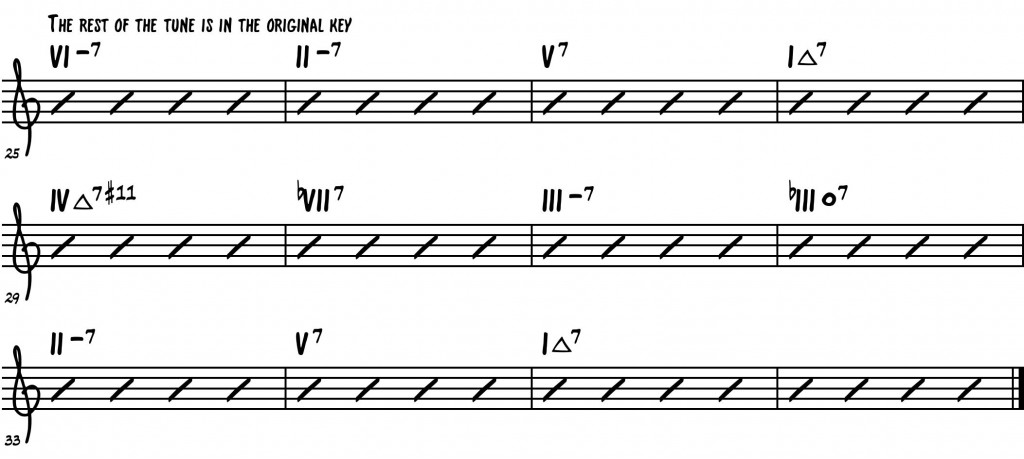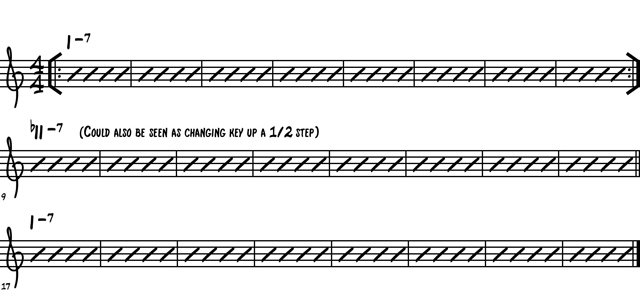In this post, I justified why I practice in 12 keys. As promised, today’s post breaks down my approach.
Jazz By Numbers
To transpose rapidly between keys, you may have to change your way of thinking. When I was a younger player, I learned melodies by pitch names (C, A, Gb…what have you) which does work, but gives little information about a note’s context. You know the note is a “C”, but how does it function? Is it a 3rd, a b9 or a “ruptured 129th”? It also makes moving to another key difficult, since it takes a lot of math to move every note by a fixed interval, one-by-one.
When I first started out, I worked out of Jerry Coker’s Patterns for Jazz – a semi-comprehensive tome of arpeggios, scales and clichés. The book writes out a bunch of patterns, pre-transposed for you, but later only gives the pattern in a single key. You end up having to do a lot of the transposing yourself, which is the secret to the whole system.
After slogging through the 1st set of patterns (the major arpeggios), I noticed that Coker always built the exercises with the same transpositions. Taking a cue from this, I developed a pattern routine:
- Analyze the pattern for structure (i.e. “C D E G” is “1 2 3 5” in C∆)
- Use the numbers to recreate in new keys (i.e. “1 2 3 5” in Ab∆ is “Ab Bb C Eb”)
- Transpose and play full range in 1/2 steps, up and down
- Ditto in whole steps
- Ditto in minor 3rds
- Ditto in major 3rds
- …circle of 4ths anyone?
- And my own weird custom pattern – up a tritone, down a 1/2 step
Side note: I recently saw a Berklee interview with Michael Brecker (posted on Casa Valdez) where he demonstrates basically the same thing.
As I improved, I began to think numerically – which was more efficient. Instead of trying to shift the whole thing a minor 3rd, note by note, I just recreated the number set in the new key. All I had to do was know the key well enough.
Applying Numbers to Tunes
So how do you leverage this keyless way of thinking when it comes to moving tunes around? It comes down to being able to understand the structure of a tune. A lot of times, this is simple…
But it can also get complex. Let’s look at “All the Things You Are”. This tune has key changes, a wide variety of chord types and an unusual 36 bar form.
Let’s look at one possible breakdown:
1. First, find all the chords in the tune that are clearly in the key of the song (AbΔ in the original key). Here it turns out that the 1st 5 bars are all just chords from diatonic AbΔ. The last 3 bars are a ii-7 V7 IΔ7 progression in CΔ. So turning that into function, we get:

2. The A’ section (or should we call it B?) is identical to the first, but up a 5th.

3. The bridge is just two ii-7 V7 IΔ7 progressions in two keys (GΔ and EΔ originally), and it ends with a V7b9b13 to take us into the last section. Here’s how I see it:

4. The last section is an extended variation on A. This time, it stays in one key with some clever passing chords.

Notes on the last section: The bVII7 is often played as a IV-7. I like the bVII7 since it keeps the circle-of-5ths bass line going. Also, the bIII°7 can be seen as a V7/b9 of the V7 chord. Try it out. Cool, right?
The structure is actually pretty clean when you look at it like this – especially given the tune’s sophistication. What we’ve created here is the plan for rebuilding the tune in any key. Just assign a key to the first I chord and the rest will fall in line.
Also, did you notice that seeing the tune this way points out subtle details in the progression? See those VI chords and the III chord? I hear a lot of players treat these as II chords. I bet not all of them do it as a creative exercise. They probably just saw the minor chords and went straight for Dorian.
Coda
Ok…so that was a mouthful, but it does spell out the way I practice tunes these days. And like anything, this gets easier as you add “formulas” to your trick bag. For instance, all the ii-7 V7 IΔ7 patterns are just one thing in my mind – a ii-V-I progression. In fact, there are 24 chords in this tune that can be summed up as ii-V-I’s. Out of 36 bars, that’s a pretty good start.
Is this for the young improviser? Probably not. If you’ve only been playing for a few years, this probably seems like a mountain. I assure you it isn’t. But it took years of theory study and countless hours of practice to get to this point. Start small.
- Get Patterns for Jazz or something like it and start thinking number & function.
- Make this a part of your daily routine so you absorb it naturally.
- Read concert charts to get practice transposing (a skill I use all the time). This is a related skill that gets you seeing intervals.
- Study theory. Try Mark Levine’s The Jazz Theory Book or Randy Halberstadt’s Metaphors for the Musician.
And if you’re a pro, you need these skills. There will be a gig where having this ability makes you look like a superhero – especially in comparison to all the players out there who can’t do it.
Guess who they’ll call the next time they need a horn player!




Cool post Adam, I’ve got that book by Jerry Coker too, pulled it out again not too long ago. He taught music here in Monterey not too long ago.
Going up a tritone and down by a half step is an interesting choice.
Thanks for writing.
-Neal
Pingback: Playing Tunes In All 12 Keys? Really? | Adam Roberts Music
Pingback: Thinking in numbers – A minor
I’m an expert writer who loves to bring smiles to people’s face.
Writing is what I do for a living and I am so passionate about this. I have worked with several associations whose mission is to help people solve problems.
I love traveling and have visited several countries in the past few years.
I’m happy to have written several books that have contributed positively to the lives of many. My books are available in several parts of the world. And I’m currently working with companies that help people save energy. Being a part of this team has open more opportunities for me to excel as a writer. I have worked with different people and met many clients as a writer.
I can handle any kind of writing and provide nothing but the best. People come to me all the time to ask if I can solve their assignment problems and I accept. I find pleasure in helping them to solve their problems as a writer.
Professional Writer – Sidney Roberts – Natalie Crawford Company
оригинальный сайт – https://hubvideo.info
Shirley Brown Ive Got To Go On Without You It Aint No Fun https://goo.slidingrockcabins.biz/37.html Living Water The Human Didge
Углубляйте качественные беклинки на ваш ресурс и увеличивайте трафик, ИКС. Разбавьте текущую ссылочную массу, усиливайте беклинки с бирж ссылок, пирамида ссылок, tier 1, tier 2, tier 3. Бессмертные ссылки с высокотрастовых сайтов на ваш ресурс, дешевле чем на биржах и аналогов на рынке беклинков. вечные ссылки на форумах
I’m all hot to share in my thoughts on the mod website! The humus is shining and modish, instantly capturing my attention.
Navigating with the promote the pages is a upbraid, thanks to the understandable interface.
The character is illuminating and captivating, providing valuable insights and resources.
I regard highly the acclaim to verse and the seamless integration of features.
The website justly delivers a monstrous practitioner experience.
blog
Whether it’s the visually appealing visuals or the well-organized layout, caboodle feels opulently rumination out.
I’m impressed alongside the endeavour look to to into creating this procedure, and I’m looking send on to exploring more of what it has to offer.
Concern for up the tremendous travail!